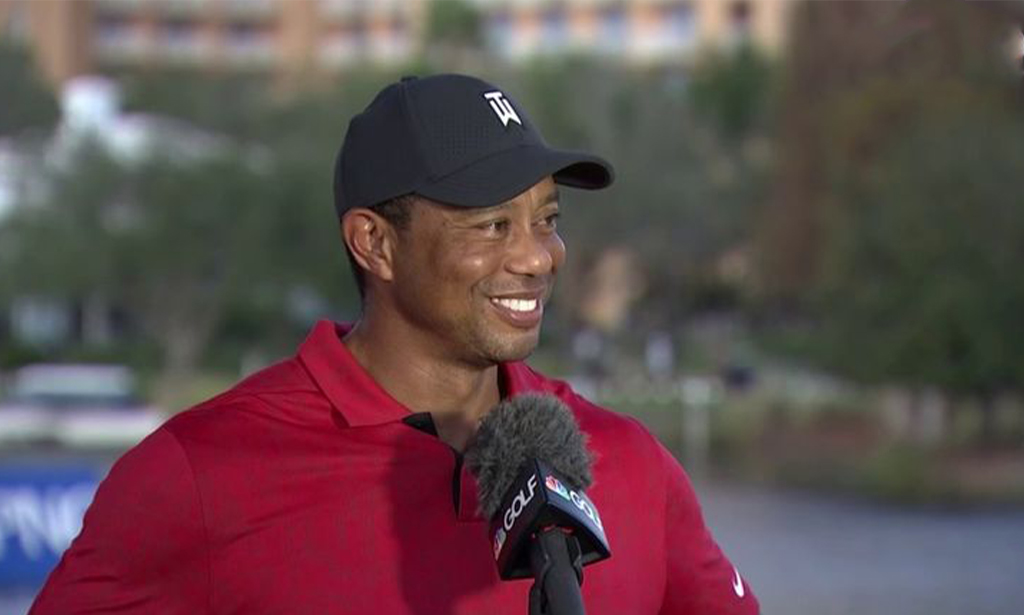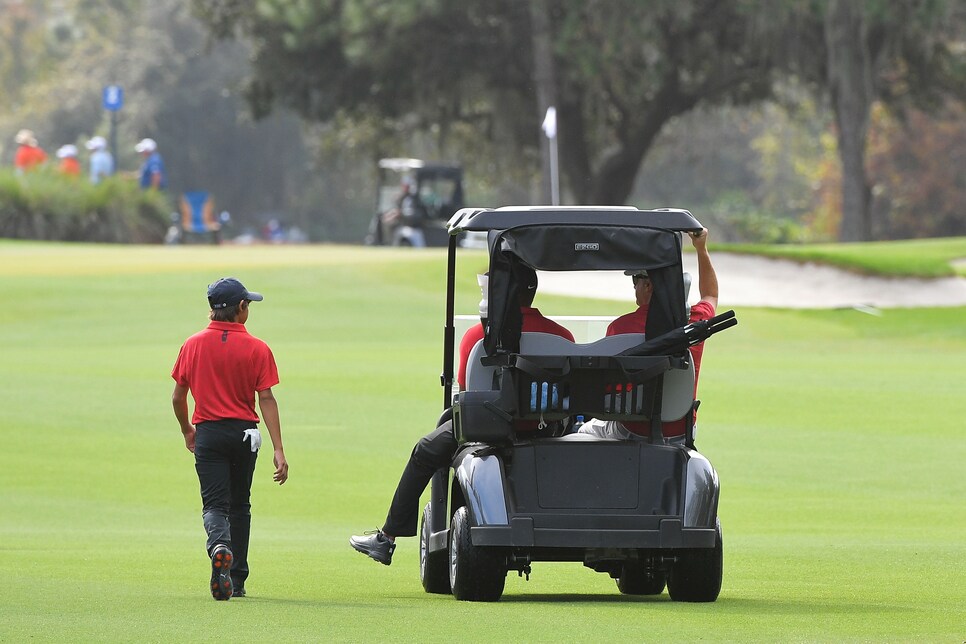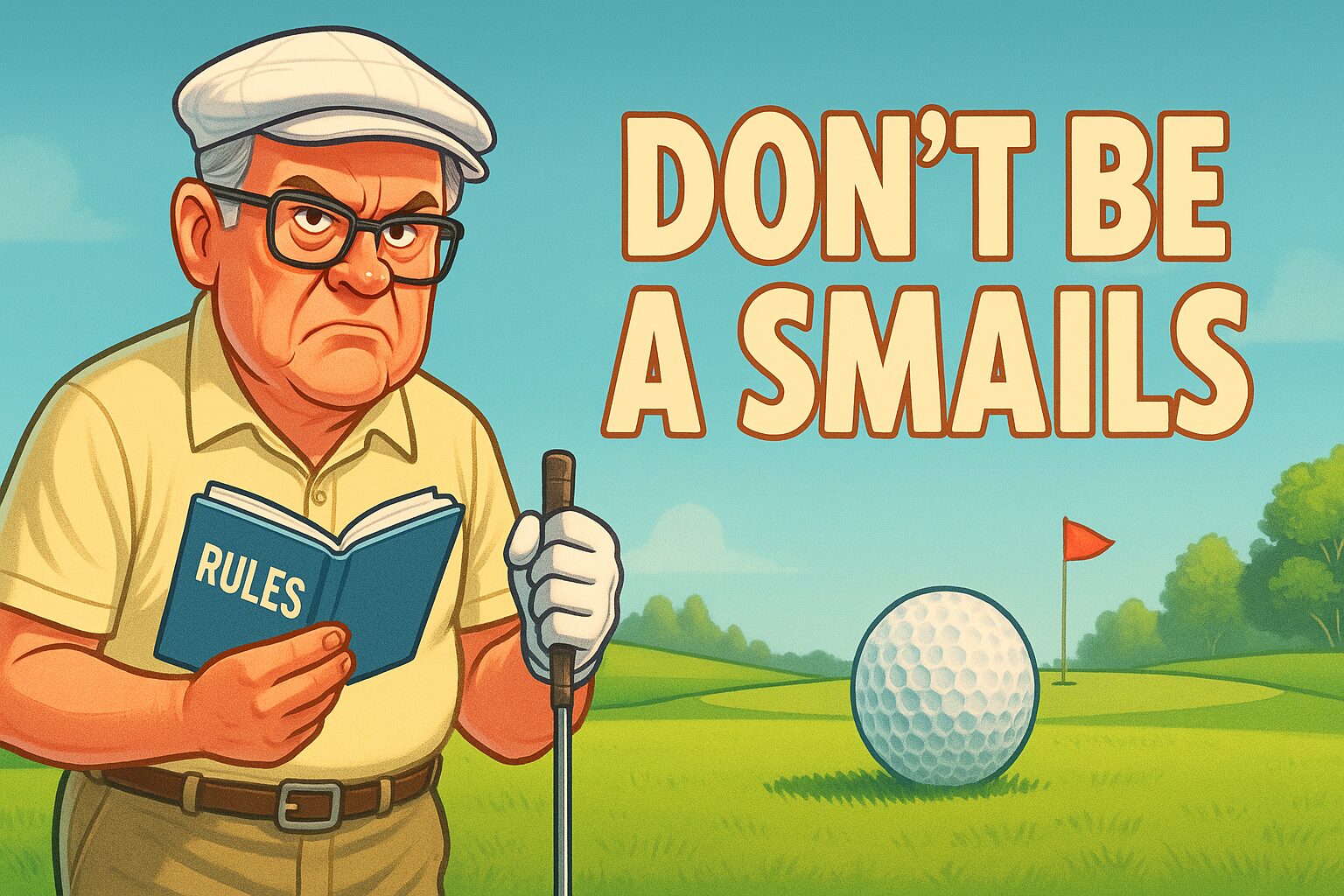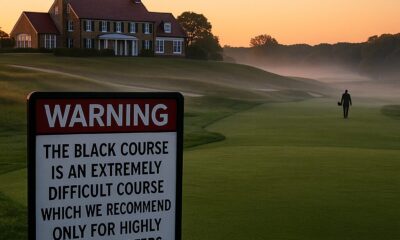Blog
After Impressive PNC, What’s Next for Tiger?

The switch flipped around the turn. Tiger Woods had been in hit-and-giggle mode for the previous two-plus days of the PNC Championship, content to play a few shots and crack a few jokes. Let us not forget that the man nearly lost his leg in February. But Tiger felt better from the moment he woke up Sunday morning, and Team Woods had the lead in sight. The smiles turned to fist-pumps. The wandering eyes locked in on the prize. Something about that Sunday red-and-black.
Tiger and Charlie put on one helluva show, dropping 11 straight birdies from Nos. 7-17 at the Ritz-Carlton Golf Club to briefly tie Team Daly for the lead. There was, incredibly, a legitimate buzz in the air for a December exhibition featuring three kids too young to drive and two men older than 80. Virtually every single spectator on site followed the Woodses all day, and those hotel guests who couldn’t score the hot ticket found a hillside where they could glimpse the action. It was the group behind, however, that produced the champion: John Daly, still smokin’ his smokes and drinking his Diet Cokes, and John Daly II, now a freshman on the Arkansas golf team and no longer Little, put in a spoiler performance that’d make 2009 Stewart Cink proud.
The Woodses’ 15-under 57 came up two shots short, in solo second, but now we’re talking semantics. Tiger will be beaming on the 30-minute flight back to Jupiter—for the way he played, the way he felt and how his 12-year-old son composed himself and performed in the high-tension moments.
Charlie Woods played a high, soft cut into the 16th green. Start it in the middle of the green, let it move toward the hole. Just like dad. Birdie. And then he topped that on the next hole, the difficult par-3 17th, when he held a 5-iron into a right-to-left wind and snuggled his ball to three feet from a water-guarded front-right flag. It was the closest anyone got on that hole, including the pros. Birdie. Both Tiger and Charlie knew they needed to eagle the par-5 finishing hole, a distinct possibility after Tiger’s second crawled just over the green. As he approached his ball, the sun gleaming off his forearms and his eyes locked on a landing spot, context flew out the window. This was Tiger being Tiger.
“The competitive juices, they are never going to go away. This is my environment. This is what I’ve done my entire life,” Tiger said afterward. “I’m just so thankful to be able to have this opportunity to do it again. Earlier this year was not a very good start to the year, and it didn’t look very good. But the last few weeks, to push as hard as we have the last seven months with taking no days off and just working our butts off each and every day, and to have this opportunity to be able to play with my son and to have these memories, for us, for both of us, our lifetime, it’s worth all the pain.”

Team Woods shot an impressiive 15-under 57—with 11 straight birdies—on Sunday to finish second.
Jensen Larson for Golf Digest
This week was always going to be a test for Woods. He’d played only two or three rounds all year, and certainly not three days in a row. He’ll be encouraged that he had noticeably more speed and pop on Sunday than the previous two days. He also had much better bottom-control, which is tour speak for being able to have the club interact with the turf/ball at the same time over and over. There were no drop-kick drivers, like there were on Saturday.
Justin Thomas, who Woods played with on Saturday, still came away beaming. “I was so impressed by the speed that he had and the shots he was hitting,” Thomas said. “At least from my perspective, it looked like a lot of the moves and everything were there.”
For all that’s been made of Woods ushering in the power era of golf, his strength has always been his irons. They have survived five knee surgeries and five back surgeries, and, for the moment, a horrific car accident. Woods had tour-level distance control all week and looked comfortable shaping the ball both ways. There were high cuts and there were low draws. The shot he hit into the par-3 eighth—a 4-iron cut that pierced through the wind and still sat soft, those are Tiger shots. There were a lot of Tiger shots this week. More than anyone expected.
“Way impressed,” said Sunday playing partner Matt Kuchar, who has played his fair share of golf with his fellow 40-pluser. “He’s still flushing it. Still has speed. Irons are spectacular. Tiger Woods of old-like irons. Huntin’ flags, pin high every time. It’s awesome.”
His driver swing is noticeably different; he’s much more flat footed at impact, a nod to the fact he’s not yet comfortable pushing off his right leg and clearing onto his left side during the downswing. There’s more wrist action at the bottom that he’d like. Because he cannot generate the speed with his legs, much of it comes from the arms. It is, ironically, somewhat analogous to the way Phil Mickelson generates speed. Whether he’ll move back toward that squat-and-clear motion as his leg strengthens remains to be seen. So much remains to be seen.
If this week proved anything, it’s that Tiger still has the game. He can still hit the golf shots … so long as he has a ride to the next one. For a man who has lived a complicated life in the public eye, his greatest challenge moving forward is, ironically, so very simple: walking. It boils down to whether he can walk 18 holes for five straight days. Because, as his caddie Joe LaCava reminded us this week, tournament golf requires a practice round. Even for Tiger. And that’s to say nothing of the practice ramp-up he’ll need to get the game to a place where it can stand up to Rahm and Rory and rough. Because of the scramble format, and the Woods boys’ overall proficiency at golf, we still haven’t seen Tiger hit a single shot out of rough.
“I’m not … I’m not at that level. I can’t compete again these guys right now, no,” Tiger said. “It’s going to take a lot of work to get to where I feel like I can compete at these guys and be at a high level.”

Tiger rides in a golf cart with his girlfriend, Erica Herman, and his daughter, Sam Woods, during Sunday’s final round.
Ben Jared
Woods did fatigue as the afternoon wore on. There were a number of grimaces. But pain—pain he can deal with. His leg has its structural integrity back; doctors told him there was no risk of further injury this week. It would just be a matter of pain management.
As for what’s next, it’s more of the same. Gym work and physical therapy, every single day, multiple times per day. Woods, who turns 46 next Thursday, said earlier this week that he has not taken a single day off in his rehab. This, a taste of the intoxicating rush of competition, will only motivate him further.
“As I told you guys in the Bahamas, I’m not going to play a full schedule ever again. I’m going to have to pick and choose what events, and even then, my body might not cooperate with that. So I don’t know how many events I’m going to be playing in. And it’s going to be up to training sessions, practice sessions, recovery tactics, all those different things to be able to do it. As I said … [I’m] protective on it now, and just so thankful to be able to do this again because it didn’t look good there for a little.”
Earlier this week, Woods scoffed at the notion of requesting a cart for a PGA Tour event. “That’s just not who I am,” he said. “That’s not how I’ve always been.” He will take exactly zero handouts on his road back, which is nowhere near its completion. And yet this week cannot be considered anything but a hugely encouraging sign.
As for the future, well, we likely won’t hear much from Tiger over the next few months. He seems to prefer dropping news out of nowhere and sending the internet into a frenzy. Until then, or until he steps into the public eye once again, he’ll return to a cadence of living that’s become all too familiar: rehab, rehab, rehab.

This article originally appeared on Golf Digest.
Blog
The Unofficial Rules of Golf: A Gentleman’s Guide to Not Being Judge Smails
The official rulebook is thicker than a dictionary and twice as boring. Let’s talk about the rules that really matter on the course: how to have fun, respect the game, and not be a stick-in-the-mud. Hint: It involves less plaid and more cosmic harmony.

You’ve seen him. I’ve seen him. The guy who quotes the USGA rulebook like it’s scripture. He’ll happily tell you your ball moved a quarter of an inch when you addressed it, costing you a penalty stroke. He’s got a plumb bob for a three-foot putt and the personality of a rake. He is, in spirit, Judge Smails. And let’s be honest, nobody wants to be Judge Smails.
The real game of golf, the one that keeps us coming back, isn’t played by those rules. It’s played by a higher law. An unwritten code of conduct that’s all about flow, friendship, and the pursuit of that one perfect shot. It’s a gentleman’s agreement with the universe.
So, let’s talk about the rules that actually matter.
1. The Cosmic Readjustment (aka The Mulligan). Your first tee shot is a mess. It goes sideways into the woods where the gophers play. The Smails of the world would tell you to take a penalty and hack it out. I say the universe is just getting warmed up. The “breakfast ball” isn’t cheating; it’s a course correction. It’s an agreement among friends that a round of golf shouldn’t be ruined before it even begins. Take another. The Dalai Lama would want you to.
2. The Art of Flow (aka Pace of Play). This isn’t about rushing. Rushing is a fool’s game. This is about flow. It’s about being ready to hit when it’s your turn. It’s about watching your friend’s shot so you can help them find it. It’s about moving with a purpose, not like you’re searching for your car keys in a dark parking lot. Don’t be the anchor that drags the whole group down. See the line, hit the ball, walk on. Nanananana.
3. The Circle of Friendship (aka Gimmes). Is the putt inside the leather? Good enough. Pick it up. Life is too short to watch your buddies sweat over an 18-inch putt for a double bogey. A gimme isn’t just a time-saver; it’s a gesture of goodwill. It says, “I trust you, you trust me, and neither of us needs the anxiety of missing this tiny putt.” It’s good for the karma, and even better for the pace of play.
4. The Final Verdict (aka The 19th Hole). The most important rule is this: no matter what happened out there, you shake hands on the 18th green and settle things over a cold drink at the 19th. The guy who shot an 82 and the guy who shot a 102 are equals in the clubhouse. The stories get better, the putts get longer, and the bad shots fade away. This is where the real game is won.
So, forget about the fine print. Focus on the feeling. Be a good playing partner, enjoy the walk, and don’t be a Smails. You’ll find your score starts to take care of itself.
Did this speak to your soul? Pass it along to your foursome to make sure everyone is on the same page. For more deep thoughts from the fairway, be sure to follow us on social media. It’s the right thing to do.
Blog
When Golf Gadgets Fail: Navigating Common Tech Mishaps on the Golf Course
A Look at What Happens When Modern Golf Gadgets Go Wrong

Imagine this: you’re on the golf course, teeing off on a beautiful, sunny day. With the help of your trusty golf gadget, you’re confident you’ll hit a birdie or even an eagle. But just when you’re about to swing, your gadget malfunctions. Suddenly, your perfect game is thrown into chaos. Welcome to the world of technology fails, where even the most advanced golf devices can sometimes let you down. In this article, we’ll explore some common tech fails and provide some tips on how to handle them.
When Golf Gadgets Let You Down
Modern golf devices, from smart clubs to digital scorecards to GPS-enabled watches, have revolutionized the game. They provide golfers with real-time data, helping them refine their swing, choose the right club, and navigate the course. But what happens when these devices fail?
Unreliable Data
One of the most common golf gadget fails is inaccurate or unreliable data. GPS devices might show the wrong distance to the pin, swing analyzers might give incorrect feedback, and digital scorecards might miscalculate your score. This can be frustrating, especially when you’re relying on these devices to improve your game.
Battery Drain
Another common issue is battery drain. Many golf gadgets require a significant amount of power, and if they’re not properly charged, they can die in the middle of a game. This leaves you without the data you need to make informed decisions on the course.
Technical Glitches and Malfunctions
Sometimes, golf devices just stop working. They might freeze, crash, or refuse to turn on. These technical glitches can be caused by software bugs, hardware issues, or even user error.
Preventing Golf Gadget Fails
While it’s impossible to prevent all golf gadget fails, there are steps you can take to minimize the risk.
Regular Updates
Keeping your devices updated can help prevent software-related issues. Regular updates often include bug fixes and improvements that can enhance the performance of your device.
Proper Charging
To avoid battery-related problems, make sure to fully charge your devices before hitting the course. Some devices also have power-saving modes that can help extend battery life.
Backup Plan
It’s always a good idea to have a backup plan in case your devices fail. This might mean carrying a traditional scorecard or having a basic understanding of how to calculate distances without a GPS.
When Gadgets Go Wrong: The Bottom Line
Golf gadgets are a fantastic tool for any golfer looking to improve their game. However, like all technology, they can sometimes fail. By understanding the common issues and how to prevent them, you can ensure you’re prepared for any tech-related hiccups on the course. After all, golf is about more than just the gadgets—it’s about the experience, the skill, and the love of the game.
Blog
Mastering the Art of Overcoming Choking under Pressure: Strategies for Peak Performance
Learn the skills needed to stay calm under pressure.

Imagine this: you’ve spent countless hours honing your skills, preparing for that big presentation, important meeting, or decisive sports match. But, when the big moment arrives, instead of performing at your best, your mind goes blank, your hands shake, and you flub it. The dreaded phenomenon of ‘choking under pressure’ can strike anyone, from the seasoned professional to the eager amateur. So, how do you overcome this common mental roadblock? In this article, we’ll explore effective strategies to help you conquer the fear of choking and elevate your performance under pressure.
Understanding Choking under Pressure
Before you can overcome choking, it’s crucial to understand what it is. Psychologists define choking as performing below your ability under pressure. This can be due to heightened anxiety, overthinking, or fear of failure. The irony is, the more you care about performing well, the more likely you are to choke.
Why Do We Choke?
Several factors contribute to choking under pressure. Here are a few:
-
- Fear of Negative Evaluation: The fear of being judged negatively by others can cause significant anxiety, leading to poor performance.
- High Stakes: When the stakes are high, and the outcome is important, the pressure can cause you to underperform.
- Overthinking: The tendency to scrutinize every detail in high-pressure situations can divert your focus from the task at hand.
Strategies to Overcome Choking
Now that we understand why we choke, let’s delve into strategies to prevent it:
- Practice Under Pressure: Simulate high-pressure situations during practice to acclimate yourself to the stress.
- Focus on the Process, Not the Outcome: Concentrating on the process helps keep your mind focused and prevents overthinking.
- Use Positive Affirmations: Positive self-talk can boost your confidence and reduce anxiety.
Case Studies: Athletes Overcoming Choking
Many successful athletes have overcome choking to deliver exceptional performances. Take Michael Jordan, for example. He often missed crucial shots early in his career but used these failures to fuel his determination and eventually became renowned for his clutch performances. Similarly, Serena Williams has bounced back from choking in several matches to claim victory, demonstrating her mental toughness.
Choking under pressure is a common phenomenon, but with the right strategies, it can be overcome. By understanding the causes of choking and implementing techniques like practicing under pressure, focusing on the process, and using positive affirmations, you can learn to perform at your best when it counts the most. Remember, it’s not about never feeling pressure; it’s about learning how to thrive within it.
As Michael Jordan said, “I’ve missed more than 9,000 shots in my career. I’ve lost almost 300 games. 26 times, I’ve been trusted to take the game-winning shot and missed. I’ve failed over and over and over again in my life. And that is why I succeed.” So, next time you face a high-pressure situation, think of it as an opportunity to grow, not a threat to be feared.
If you’ve enjoyed this article and want to learn more about mastering your mental game, subscribe to our newsletter for more tips and strategies. Or, if you’re ready to take your mental toughness to the next level, check out our other articles designed to help you conquer pressure and perform at your peak.
-

 Product Review6 years ago
Product Review6 years agoThe Perfect Practice Putting Mat Review by Jason Tenzer
-

 Blog4 years ago
Blog4 years agoLoophole Rule Offers PGA Tour Pros a Mulligan
-

 Blog4 years ago
Blog4 years ago2021 Buyer’s Guide: The Top 10 Value Golf Balls For Distance & Feel
-

 Blog5 years ago
Blog5 years agoGolf Marriage Counselor
-

 Product Review6 years ago
Product Review6 years agoTHE ADJUSTABLE IRONS: WALKING STICKS GOLF CLUBS
-

 Blog6 years ago
Blog6 years ago9 Biggest Chokes Of The Past Decade
-

 Blog4 years ago
Blog4 years agoWhat Your Golf Clubs Say About You
-

 Equipment6 years ago
Equipment6 years agoOHK Sports Interview by Jason Tenzer































